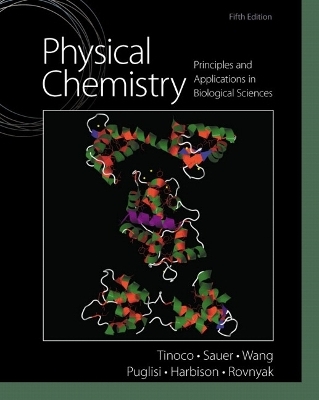
18-week
Pearson (Hersteller)
978-0-321-90550-5 (ISBN)
- Titel ist leider vergriffen;
keine Neuauflage - Artikel merken
This ISBN is for the Modified Mastering access card. Pearson eText is included.
Physical Chemistry: Principles and Applications in Biological Sciences is written specifically for the life-science student and covers core aspects of biophysical chemistry – while showing how Biochemists and Biophysicists use principles of Physical Chemistry to solve real problems in biological systems.
Personalize learning with Mastering Chemistry with Pearson eText
This flexible digital platform combines unrivaled content, online assessments, and customizable features to personalize learning and improve results, one student at a time.
Pearson eText is an easy-to-use digital textbook available within Mastering that lets you read, highlight, take notes, and review key vocabulary all in one place.
NOTE: Before purchasing, check with your instructor to confirm the correct ISBN. Several versions of the MyLab® and Mastering® platforms exist for each title, and registrations are not transferable. To register for and use MyLab or Mastering, you may also need a Course ID, which your instructor will provide.
Used books, rentals, and purchases made outside of Pearson
If purchasing or renting from companies other than Pearson, the access codes for the Mastering platform may not be included, may be incorrect, or may be previously redeemed. Check with the seller before completing your purchase.
Ignacio Tinoco was an undergraduate at the University of New Mexico, a graduate student at the University of Wisconsin, and a postdoctoral fellow at Yale. He then went to the University of California, Berkeley, where he has remained. His research interest has been on the structures of nucleic acids, particularly RNA. He was chairman of the Department of Energy committee that recommended in 1987 a major initiative to sequence the human genome. His present research is on unfolding single RNA molecules by force. Kenneth Sauer grew up in Cleveland, Ohio, and received his A.B. in chemistry from Oberlin College. Following his Ph.D. studies in gas-phase physical chemistry at Harvard, he spent three years teaching at the American University of Beirut, Lebanon. A postdoctoral opportunity to learn from Melvin Calvin about photosynthesis in plants led him to the University of California, Berkeley, where he has been since 1960. Teaching general chemistry and biophysical chemistry in the Chemistry Department has complemented research in the Physical Biosciences Division of the Lawrence Berkeley National Lab involving spectroscopic studies of photosynthetic light reactions and their role in water oxidation. His other activities include reading, renaissance and baroque choral music, canoeing, and exploring the Sierra Nevada with his family and friends. James C. Wang was on the faculty of the University of California, Berkeley, from 1966 to 1977. He then joined the faculty of Harvard University, where he is presently Mallinckrodt Professor of Biochemistry and Molecular Biology. His research focuses on DNA and enzymes that act on DNA, especially a class of enzymes known as DNA topoisomerases. He has taught courses in biophysical chemistry and molecular biology and has published over 200 research articles. He is a member of Academia Sinica, the American Academy of Arts and Sciences, and the U.S. National Academy of Sciences. Joseph Puglisi was born and raised in New Jersey. He received his B.A. in chemistry from The Johns Hopkins University in 1984 and his Ph.D. from the University of California, Berkeley, in 1989. He has studied and taught in Strasbourg, Boston, and Santa Cruz, and is currently professor of structural biology at Stanford University. His research interests are in the structure and mechanism of the ribosome and the use of NMR spectroscopy to study RNA structure. He has been a Dreyfus Scholar, Sloan Scholar, and Packard Fellow. Gerard Harbison was born in the United Kingdom and raised there and in Ireland. He received his B.A. in biochemistry from Trinity College, Dublin, and his Ph.D. in biophysics from Harvard University. After a brief postdoctoral sojourn at the Max-Planck Institute for Polymer Research in Mainz, Germany, he joined the faculty of Stony Brook University, and then moved to the University of Nebraska Lincoln. He is a Dreyfus Scholar, Lilly Foundation Teacher-Scholar and Presidential Young Investigator. His research interests are in nuclear magnetic resonance and electronic structure theory. David Rovnyak, a native of Charlottesville, Virginia, earned his B.S. in Chemistry at the University of Richmond and Ph.D. in physical chemistry from the Massachusetts Institute of Technology. After performing post-doctoral study at the Harvard Medical School under an NIH-NRSA fellowship, he joined Bucknell University where he has been recognized with the Bucknell Presidential Teaching Award for Excellence. His research focuses on new methods for NMR spectroscopy and physico-chemical behavior of bile acids.
Brief Contents
Chapter 1: Introduction
Chapter 2: The First Law: Energy is Conserved
Chapter 3: The Second Law: The Entropy of the Universe Increases
Chapter 4: Free Energy and Chemical Equilibria
Chapter 5: The Statistical Foundations of Biophysical Chemistry
Chapter 6: Physical Equilibria
Chapter 7: Electrochemistry
Chapter 8: The Motion of Biological Molecules
Chapter 9: Kinetics: Rates of Chemical Reactions
Chapter 10: Enzyme Kinetics
Chapter 11: Molecular Structures and Interactions: Theory
Chapter 12: Molecular Structures and Interactions: Biomolecules
Chapter 13: Optical Spectroscopy
Chapter 14: Magnetic Resonance
Chapter 15: Macromolecular Structure and X-Ray Diffraction
| Erscheint lt. Verlag | 20.3.2018 |
|---|---|
| Sprache | englisch |
| Maße | 151 x 229 mm |
| Gewicht | 18 g |
| Themenwelt | Naturwissenschaften ► Chemie ► Physikalische Chemie |
| ISBN-10 | 0-321-90550-4 / 0321905504 |
| ISBN-13 | 978-0-321-90550-5 / 9780321905505 |
| Zustand | Neuware |
| Informationen gemäß Produktsicherheitsverordnung (GPSR) | |
| Haben Sie eine Frage zum Produkt? |